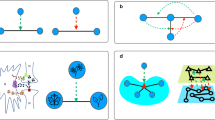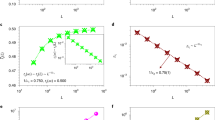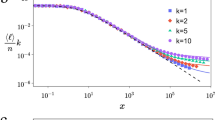Abstract
How a complex network is connected crucially impacts its dynamics and function. Percolation, the transition to extensive connectedness on gradual addition of links, was long believed to be continuous, but recent numerical evidence of ‘explosive percolation’ suggests that it might also be discontinuous if links compete for addition. Here we analyse the microscopic mechanisms underlying discontinuous percolation processes and reveal a strong impact of single-link additions. We show that in generic competitive percolation processes, including those showing explosive percolation, single links do not induce a discontinuous gap in the largest cluster size in the thermodynamic limit. Nevertheless, our results highlight that for large finite systems single links may still induce substantial gaps, because gap sizes scale weakly algebraically with system size. Several essentially macroscopic clusters coexist immediately before the transition, announcing discontinuous percolation. These results explain how single links may drastically change macroscopic connectivity in networks where links add competitively.
This is a preview of subscription content, access via your institution
Access options
Subscribe to this journal
Receive 12 print issues and online access
$209.00 per year
only $17.42 per issue
Buy this article
- Purchase on Springer Link
- Instant access to full article PDF
Prices may be subject to local taxes which are calculated during checkout


 decay algebraically with system size N for weakly discontinuous transitions.
decay algebraically with system size N for weakly discontinuous transitions.


Similar content being viewed by others
References
Strogatz, S. H. Exploring complex networks. Nature 410, 268–276 (2001).
Newman, M. E. J., Watts, D. J. & Strogatz, S. H. Random graph models of social networks. Proc. Natl Acad. Sci. 99, 2566–2572 (2002).
Song, C., Havlin, S. & Makse, H. A. Origins of fractality in the growth of complex networks. Nature Phys. 2, 275–281 (2006).
Parshani, R., Bulyrev, S. V. & Havlin, S. Interdependent networks: Reducing the coupling strength leads to a change from a first to second order percolation transition. Phys. Rev. Lett. 105, 048701 (2010).
Parshani, R., Bulyrev, S. V., Stanley, H. E. & Havlin, S. Catastrophic cascade of failures in interdependent networks. Nature 464, 1025–1028 (2010).
Ben-Avraham, D. & Havlin, S. Diffusion and Reactions in Fractals and Disordered Systems (Cambridge Univ. Press, 2001).
Solomon, S. G., Weisbucha, L. d. A., Janc, N. & Stauffer, D. Social percolation model. Physica A 277, 239–247 (2000).
Goldstone, R. L. & Janssena, M. A. Computational models of collective behavior. Trends Cognitive Sci. 9, 424–430 (2005).
Dorogovtsev, S. N., Goltsev, A. V. & Mendes, J. F. F. Critical phenomena in complex networks. Rev. Mod. Phys. 80, 1275–1335 (2008).
Rozenfeld, H. D., Gallos, L. K. & Makse, H. A. Explosive percolation in the human protein homology networks. Eur. Phys. J. E 75, 305–310 (2010).
Hufnagel, L., Brockmann, D. & Geisel, T. Forecast and control of epidemics in a globalized world. Proc. Natl Acad. Sci. USA 101, 15124–15129 (2004).
D’Souza, R. M. Complex networks: Structure comes to random graphs. Nature Phys. 5, 627–628 (2009).
Bunde, A. & Havlin, S. Fractals and Disordered Systems (Springer, 1996).
Bollobás, B. & Riordan, O. Percolation (Cambridge Univ. Press, 2006).
Stauffer, D. & Aharony, A. Introduction to Percolation Theory (Taylor and Francis, 1993).
Grimmett, G. Percolation (Springer, 1999).
Achlioptas, D., D’Souza, R. M. & Spencer, J. Explosive percolation in random networks. Science 323, 1453–1455 (2009).
Bohmann, T. Emergence of connectivity in networks. Science 323, 1438–1439 (2009).
Cho, Y. S., Kim, J. S., Park, J., Kahng, B. & Kim, D. Percolation transitions in scale-free networks under the Achlioptas process. Phys. Rev. Lett. 103, 135702 (2009).
Radicchi, F. & Fortunato, S. Explosive percolation in scale-free networks. Phys. Rev. Lett. 103, 168701 (2009).
Ziff, R. M. Explosive growth in biased dynamic percolation on two-dimensional regular lattice networks. Phys. Rev. Lett. 103, 045701 (2009).
Cho, Y. S., Kahng, B. & Kim, D. Cluster aggregation model for discontinuous percolation transitions. Phys. Rev. E 81, 030103 (2010).
Friedman, E. J. & Landsberg, A. S. Construction and analysis of random networks with explosive percolation. Phys. Rev. Lett. 103, 255701 (2009).
Moreira, A. A., Oliveira, E. A., Reis, S. D. S., Herrmann, H. J. & Andrade, J. S. Hamiltonian approach for explosive percolation. Phys. Rev. E 81, 040101 (2010).
Radicchi, F. & Fortunato, S. Explosive percolation: A numerical analysis. Phys. Rev. E 81, 036110 (2010).
D’Souza, R. M. & Mitzenmacher, M. Local cluster aggregation models of explosive percolation. Phys. Rev. Lett. 104, 195702 (2010).
Manna, S. S. & Chatterjee, A. A new route to explosive percolation. Physica A 390, 177–182 (2011).
Breskin, I., Soriano, J., Moses, E. & Tlusty, T. Percolation in living neural networks. Phys. Rev. Lett. 97, 188102 (2006).
Soriano, J., Martinez, M. R., Tlusty, T. & Moses, E. Development of input connections in neural cultures. Proc. Natl Acad. Sci. USA 105, 13758–13763 (2008).
Beveridge, A., Bohman, T., Frieze, A. & Pikhurko, O. Product rule wins a competitive game. Proc. Am. Math. Soc. 135, 3061–3071 (2007).
Binder, K. Theory of first-order phase transitions. Rep. Prog. Phys. 50, 783–859 (1987).
Goldenfeld, N. D. Lectures on Phase Transitions and the Renormalisation Group (Addison-Wesley, 1992).
Ziff, R. M. Scaling behavior of explosive percolation on the square lattice. Phys. Rev. E 82, 051105 (2010).
da Costa, R. A., Dorogovtsev, S. N., Goltsev, A. V. & Mendes, J. F. F. Explosive percolation transition is actually continuous. Preprint at http://arxiv.org/abs/1009.2534v2 (2010).
Spencer, J. & Wormald, N. Birth control for giants. Combinatorica 27, 587–628 (2008).
Spencer, J. The giant component: The golden anniversary. Not. Am. Math. Soc. 57, 720–724 (2010).
Araújo, N. A. M. & Herrmann, H. J. Explosive percolation via control of the largest cluster. Phys. Rev. Lett. 105, 035701 (2010).
Timme, M. Does dynamics reflect topology in directed networks? Europhys. Lett. 76, 367–373 (2006).
Memmesheimer, R. M. & Timme, M. Designing complex networks. Physica D 224, 182–201 (2006).
Urbanc, B. et al. Aggregation and disaggregation of senile plaques in Alzheimer disease. Proc. Natl Acad. Sci. USA 94, 7612–7616 (1996).
Dinsmore, A. D., Prasad, V., Wong, I. Y. & Weitz, D. A. Microscopic structure and elasticity of weakly aggregated colloidal gels. Phys. Rev. Lett. 96, 185502 (2006).
Acknowledgements
We thank N. Goldenfeld and I. Kanter for discussions. Supported by the Federal Ministry of Education and Research (BMBF) Germany under grant number 01GQ1005B (A.L. and M.T.) and by a grant of the Max Planck Society to M.T.
Author information
Authors and Affiliations
Contributions
All authors conceived and designed the research, contributed analysis tools and analysed the data. J.N. carried out the numerical experiments. All authors worked out the theory and wrote the manuscript.
Corresponding author
Ethics declarations
Competing interests
The authors declare no competing financial interests.
Supplementary information
Supplementary Information
Supplementary Information (PDF 2577 kb)
Rights and permissions
About this article
Cite this article
Nagler, J., Levina, A. & Timme, M. Impact of single links in competitive percolation. Nature Phys 7, 265–270 (2011). https://doi.org/10.1038/nphys1860
Received:
Accepted:
Published:
Issue Date:
DOI: https://doi.org/10.1038/nphys1860
This article is cited by
-
Discontinuous emergence of a giant cluster in assortative scale-free networks
Journal of the Korean Physical Society (2022)
-
Connecting complex networks to nonadditive entropies
Scientific Reports (2021)
-
Discontinuous epidemic transition due to limited testing
Nature Communications (2021)
-
Universal gap scaling in percolation
Nature Physics (2020)



